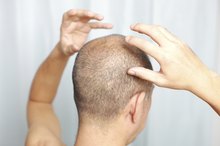What Are the Causes of Mustache Hair Loss?
A man's mustache grows just like scalp hair--from hair follicles situated in your skin. Some men grow a mustache that's thick and full, while others' are sparse and thin, just like the variations of scalp hair from one person to the next. Illness, injury and hormonal imbalance can all cause you to suffer from mustache hair loss; in most cases your facial hair will grow back after the underlying cause is addressed.
Cancer Treatment
Hair loss due to cancer treatments, such as radiation and chemotherapy, is a widely-known side effect. According to the American Cancer Society, losing your hair from the potent drugs is not limited to scalp hair. People of both genders who undergo treatment for cancer may find that body hair, including a man's mustache, can also fall out during the course of treatment. In most cases, hair regrowth begins after chemotherapy and radiation has been completed.
- Hair loss due to cancer treatments, such as radiation and chemotherapy, is a widely-known side effect.
- People of both genders who undergo treatment for cancer may find that body hair, including a man's mustache, can also fall out during the course of treatment.
Alopecia Areata Universalis
Why Don't Some People Have Eyelashes?
Learn More
Alopecia areata universalis is an auto-immune condition in which you lose hair on your scalp and your body, including facial hair. Your immune system essentially attacks itself, and de-activates functioning hair follicles, which leads to hair loss. Medications and other treatments may help reduce the inflammation in your hair follicles, which allows them to function properly again and grow hair. According to the National Alopecia Areata Foundation, alopecia areata universalis is not as common as other forms of alopecia that affect only scalp hair 1.
- Alopecia areata universalis is an auto-immune condition in which you lose hair on your scalp and your body, including facial hair.
- Your immune system essentially attacks itself, and de-activates functioning hair follicles, which leads to hair loss.
Low Testosterone
Men who have low testosterone levels due to a medical condition called hypogonadism--also called testicular failure--may lose mustache hair or are unable to grow facial hair in the first place 2. The National Institutes of Health MedlinePlus website explains that testicular failure can be the result of illness, injury or medication use 2. Symptoms can include a regression of or delayed onset of secondary sex characteristics, such as facial, armpit and pubic hair, infertility and lack of muscle development. Testosterone therapy may be a solution for men who have low hormone levels that affect their mustaches.
Related Articles
References
- National Alopecia Areata Foundation: Types of Alopecia Areata
- MedlinePlus: Testicular Failure
- International Alliance of Hair Restoration Surgeons: Are Thin Hair Shafts a Problem For Facial Hair Transplants?
- Al-refu K. Hair loss in children: common and uncommon causes; clinical and epidemiological study in jordan. Int J Trichology. 2013;5(4):185-9. doi: 10.4103/0974-7753.130393
- Hay RJ. Tinea Capitis: Current Status. Mycopathologia. 2017;182(1-2):87-93. doi: 10.1007/s11046-016-0058-8.
- Grant JE, Chamberlain SR. Trichotillomania. Am J Psychiatry. 2016;173(9):868-74. doi: 10.1176/appi.ajp.2016.15111432
- Pratt CH, King LE, Messenger AG, Christiano AM, Sundberg JP. Alopecia areata. Nat Rev Dis Primers. 2017;3:17011. doi: 10.1038/nrdp.2017.11
- Malkud S. Telogen Effluvium: A Review. J Clin Diagn Res. 2015;9(9):WE01-3. doi: 10.7860/JCDR/2015/15219.6492
- National Alopecia Areata Foundation. Alopecia.
Writer Bio
Erica Roth has been a writer since 2007. She is a member of the Society of Professional Journalists and was a college reference librarian for eight years. Roth earned a Bachelor of Arts in French literature from Brandeis University and Master of Library Science from Simmons College Graduate School of Library and Information Science. Her articles appear on various websites.








